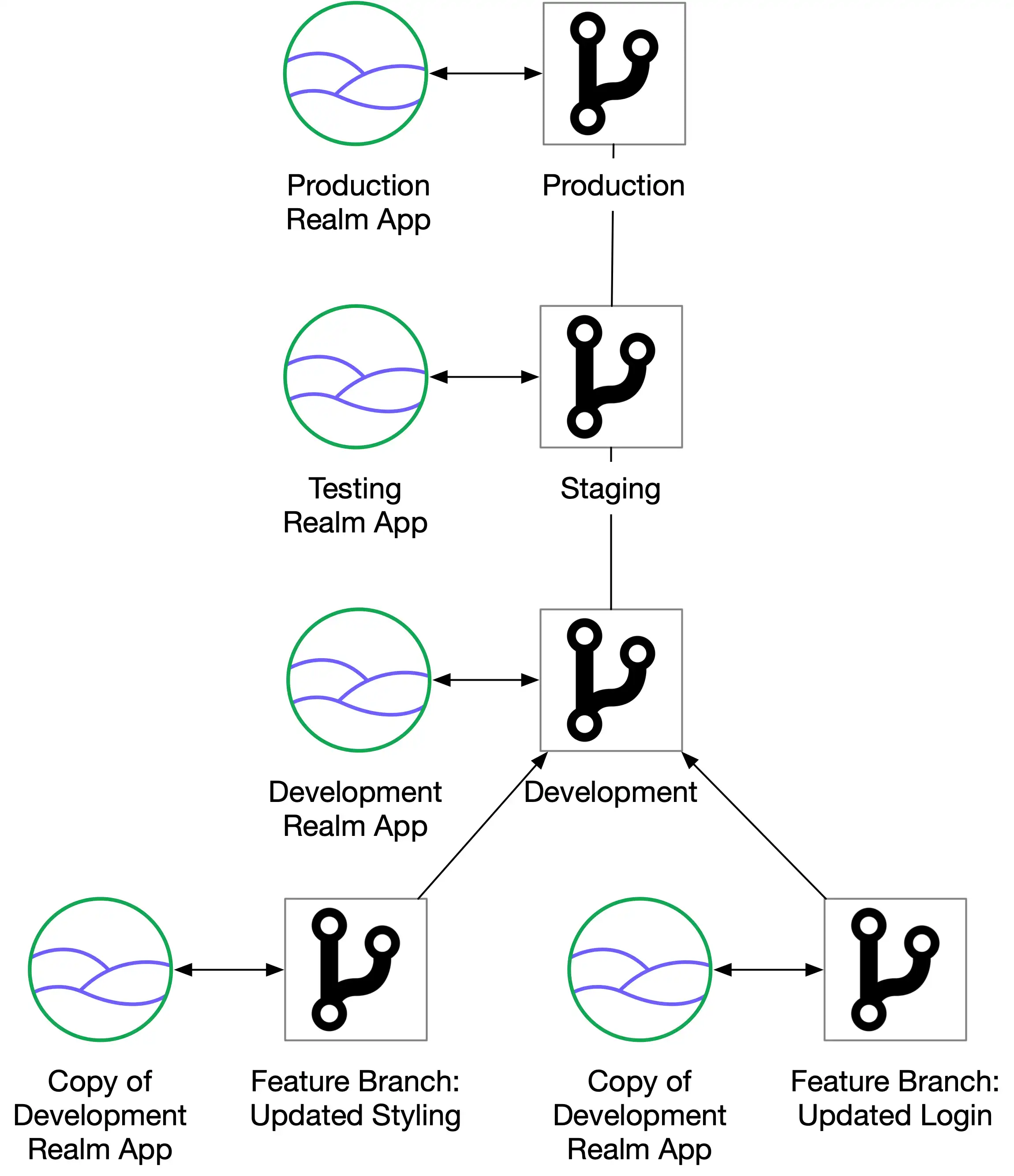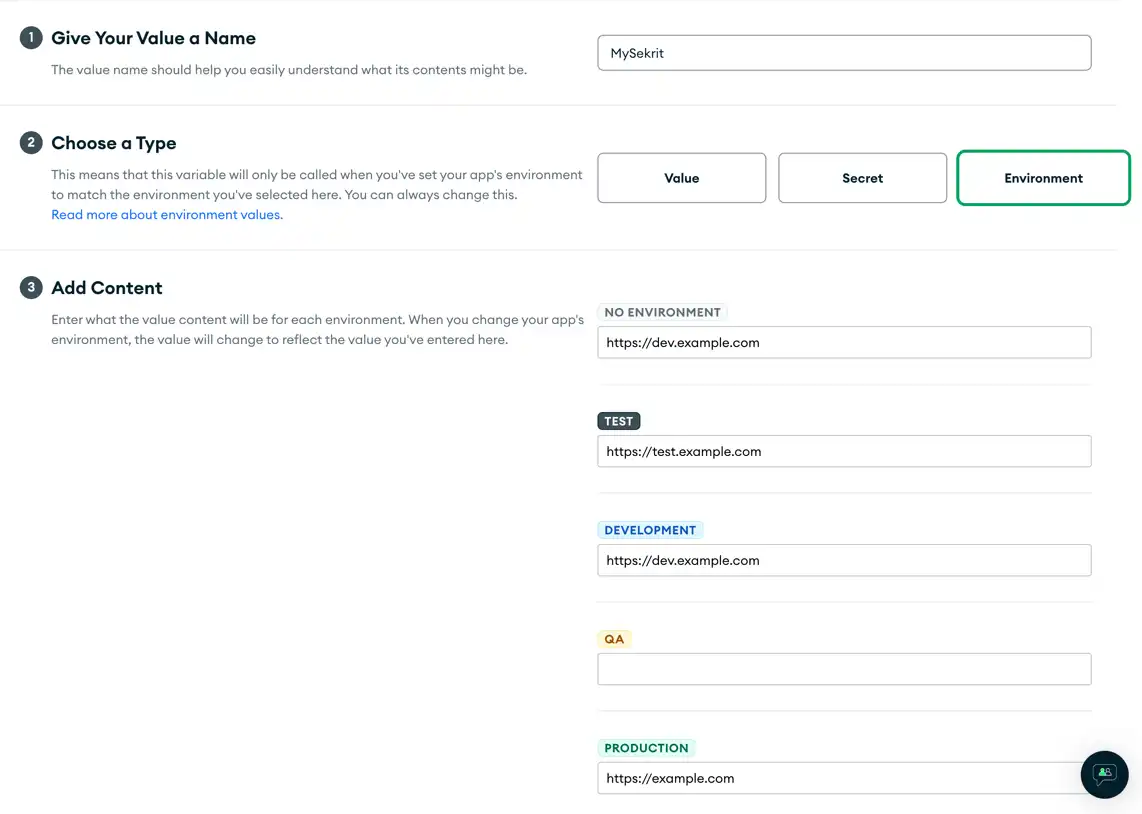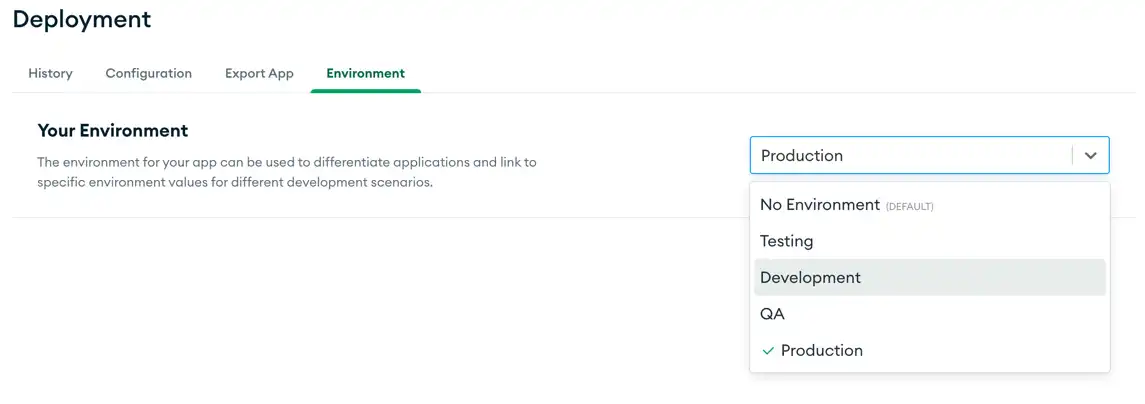Overview
App Environments are a way to organize your development workflow and effectively reuse code. You can use App Environments to define different multiple versions of global configuration values and then switch between them by changing the App's current environment.
App Services supports a set of built-in environment names that each represent a stage of your development workflow:
"""development""testing""qa""production"
Environment Values
For each environment, you can define a set of environment values that are available to your application when that environment is active.
For example, you might use different values for an API's baseUrl
configuration depending on whether you're developing a new feature or
deploying to production.
The values for an environment are stored as a single JSON object. You can set the field names and corresponding values to whatever you want.
You can access values from the current environment by field name:
Use context.environment in Functions.
Use
%%environmentin rule expressions.Use Templated Configurations in your App's configuration files.
How to Use Environments
Environment tags each represent a specific stage of your development process. You can define a separate App for each environment, where each App uses the same set of configuration files but has a distinct environment tag. To learn how, see Copy an App.
For example, a typical development process may have three development
stages: development, testing, and production. You could use
a separate App for each stage and use different environment values for
each App.
You can also use unique applications to test individual feature
branches. For example, you might have a core development App that
developers fork for their feature branches. When a feature branch moves
into testing, you can use the core testing App instead.
To learn how to incorporate environments into your CI/CD workflow, see Set Up a CI/CD Pipeline. For a full example that manages testing, deployment, and other tasks for a real application, see: How to Build CI/CD Pipelines for App Services Apps using GitHub Actions.

Before You Begin
You will need the following to define an App Environment in the Atlas UI:
A MongoDB Atlas account with Project Owner permissions. To learn how to sign up for a free account, see Get Started with Atlas.
You will need the following to define an App Environment in the CLI:
A MongoDB Atlas account with Project Owner permissions. To learn how to sign up for a free account, see Get Started with Atlas.
A MongoDB Atlas Admin API public/private key pair. The API key must have Project Owner permissions to work with App Services Admin API.
A copy of App Services CLI installed and added to your local system
PATH. To learn how, see Install App Services CLI.Your App's client App ID. This is the unique string that contains your App name, e.g.
"myapp-abcde". To learn how to find your App ID, see Get App Metadata.
You will need the following to define an App Environment with the Admin API:
A MongoDB Atlas account with Project Owner permissions. To learn how to sign up for a free account, see Get Started with Atlas.
A MongoDB Atlas Admin API public/private key pair. The API key must have Project Owner permissions to work with App Services Admin API.
Your App's internal ObjectId hex string and the Project ID of the Atlas Project that contains your App. To learn how to find these, see Get App Metadata.
Procedure
Pull the Latest Version of Your App
Get a local copy of your App's configuration files. To get the latest version of your App, run the following command:
appservices pull --remote="<Your App ID>"
You can also export a copy of your application's configuration files from the UI or with the Admin API. To learn how, see Export an App.
Define One or More Environments
The /environments directory contains a .json file
for each supported environment tag. Each file defines all of
the environment values for its corresponding environment.
App Services supports the following environment tags:
"""development""testing""qa""production"
Open the file for each environment you want to use. In each
file, add an entry to the values subdocument that maps
the value's name to its value in that environment.
Example
The following configurations define the baseUrl environment value in
the production and development environments.
{ "values": { "baseUrl": "https://example.com" } }
{ "values": { "baseUrl": "https://dev.example.com" } }
Authenticate a MongoDB Atlas User
Call the admin user authentication endpoint with your MongoDB Atlas API key pair:
curl -X POST \ https://services.cloud.mongodb.com/api/admin/v3.0/auth/providers/mongodb-cloud/login \ -H 'Content-Type: application/json' \ -H 'Accept: application/json' \ -d '{ "username": "<Public API Key>", "apiKey": "<Private API Key>" }'
If authentication succeeds, the response body contains a JSON object
with an access_token value:
{ "access_token": "<access_token>", "refresh_token": "<refresh_token>", "user_id": "<user_id>", "device_id": "<device_id>" }
The access_token grants access to the App Services Admin API. You
must include it as a Bearer token in the Authorization header for
all Admin API requests.
Define Environment Values
You can define environment values for your App by calling
the Create an Environment Value
endpoint. Each environment value has a name and a values
object that maps environment tags to the value in the
environment.
curl -X GET \ https://services.cloud.mongodb.com/api/admin/v3.0/groups/{groupId}/apps/{appId}/environment_values/{environmentValueId} \ -H 'Authorization: Bearer <access_token>' \ -d '{ "name": "myEnvironmentValue", "values": { "none": "alpha", "development": "beta", "testing": "gamma", "qa": "delta", "production": "epsilon" } }'
Set Your App Environment
You can set your App's environment tag by calling the Set the App Environment endpoint.
curl -X PUT \ https://services.cloud.mongodb.com/api/admin/v3.0/groups/{groupId}/apps/{appId}/environment \ -H 'Authorization: Bearer <access_token>' \ -d '{ "environment": "production" }'

